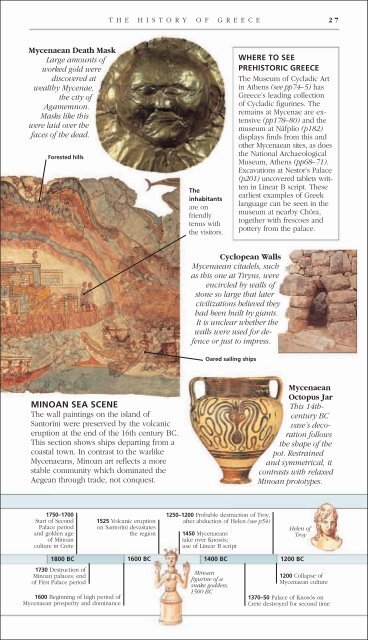Create successful ePaper yourself
Turn your PDF publications into a flip-book with our unique Google optimized e-Paper software.
Mycenaean Death Mask<br />
Large amounts <strong>of</strong><br />
worked gold were<br />
discovered at<br />
wealthy Mycenae,<br />
the city <strong>of</strong><br />
Agamemnon.<br />
Masks like this<br />
were laid over the<br />
faces <strong>of</strong> the dead.<br />
Forested hills<br />
MINOAN SEA SCENE<br />
The wall paintings on the island <strong>of</strong><br />
Santoríni were preserved by the volcanic<br />
eruption at the end <strong>of</strong> the 16th century BC.<br />
This section shows ships departing from a<br />
coastal town. In contrast to the warlike<br />
Mycenaeans, Minoan art reflects a more<br />
stable community which dominated the<br />
Aegean through trade, not conquest.<br />
1750–1700<br />
Start <strong>of</strong> Second<br />
Palace period<br />
and golden age<br />
<strong>of</strong> Minoan<br />
culture in Crete<br />
1730 Destruction <strong>of</strong><br />
Minoan palaces; end<br />
<strong>of</strong> First Palace period<br />
1600 Beginning <strong>of</strong> high period <strong>of</strong><br />
Mycenaean prosperity and dominance<br />
THE HISTORY OF GREECE 27<br />
1525 Volcanic eruption<br />
on Santoríni devastates<br />
the region<br />
The<br />
inhabitants<br />
are on<br />
friendly<br />
terms with<br />
the visitors.<br />
Cyclopean Walls<br />
Mycenaean citadels, such<br />
as this one at Tiryns, were<br />
encircled by walls <strong>of</strong><br />
stone so large that later<br />
civilizations believed they<br />
had been built by giants.<br />
It is unclear whether the<br />
walls were used for defence<br />
or just to impress.<br />
Oared sailing ships<br />
1250–1200 Probable destruction <strong>of</strong> Troy,<br />
after abduction <strong>of</strong> Helen (see p54)<br />
1450 Mycenaeans<br />
take over Knosós;<br />
use <strong>of</strong> Linear B script<br />
Minoan<br />
figurine <strong>of</strong> a<br />
snake goddess,<br />
1500 BC<br />
WHERE TO SEE<br />
PREHISTORIC GREECE<br />
The Museum <strong>of</strong> Cycladic Art<br />
in Athens (see pp74–5) has<br />
Greece’s leading collection<br />
<strong>of</strong> Cycladic figurines. The<br />
remains at Mycenae are extensive<br />
(pp178–80) and the<br />
museum at Náfplio (p182)<br />
displays finds from this and<br />
other Mycenaean sites, as does<br />
the National Archaeological<br />
Museum, Athens (pp68–71).<br />
Excavations at Nestor’s Palace<br />
(p201) uncovered tablets written<br />
in Linear B script. These<br />
earliest examples <strong>of</strong> Greek<br />
language can be seen in the<br />
museum at nearby Chóra,<br />
together with frescoes and<br />
pottery from the palace.<br />
Mycenaean<br />
Octopus Jar<br />
This 14thcentury<br />
BC<br />
vase’s decoration<br />
follows<br />
the shape <strong>of</strong> the<br />
pot. Restrained<br />
and symmetrical, it<br />
contrasts with relaxed<br />
Minoan prototypes.<br />
Helen <strong>of</strong><br />
Troy<br />
1800 BC 1600 BC 1400 BC 1200 BC<br />
1200 Collapse <strong>of</strong><br />
Mycenaean culture<br />
1370–50 Palace <strong>of</strong> Knosós on<br />
Crete destroyed for second time


